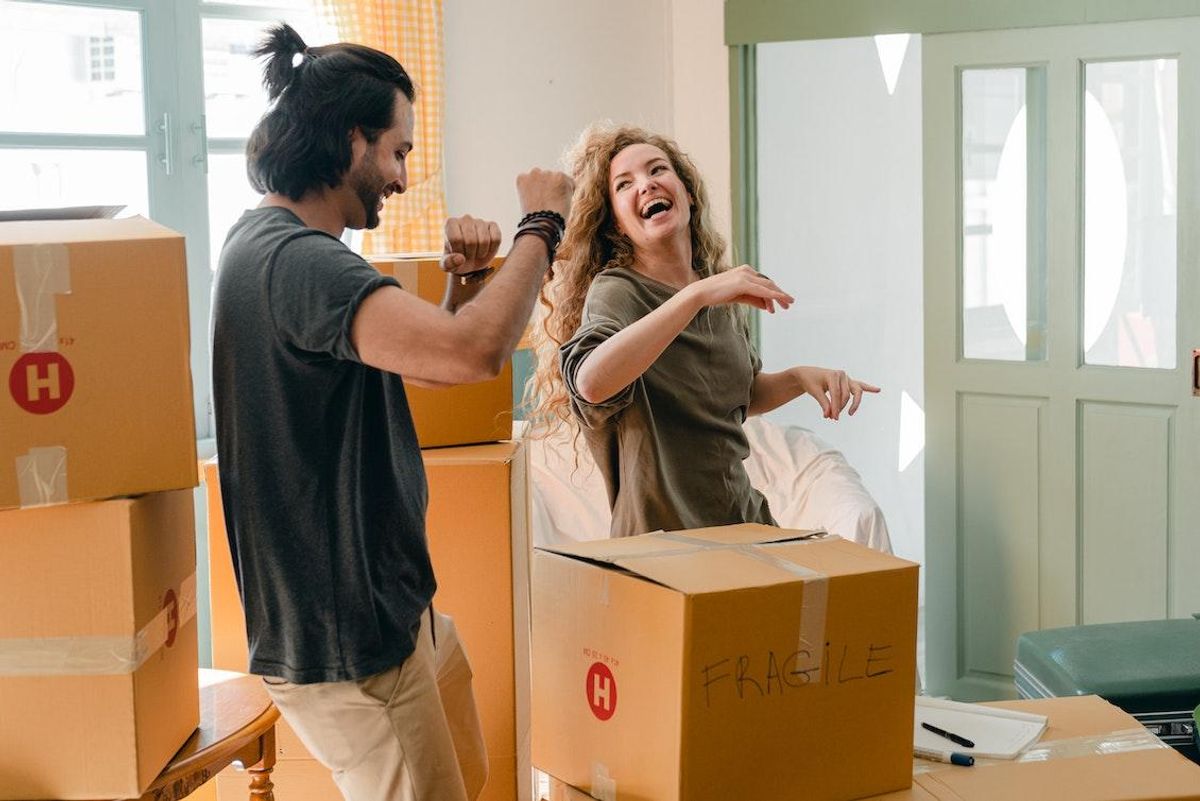A growing number of married Americans are together but live in separate homes. Here's why.
Nearly four million Americans don't live with their spouses.

A couple celebrates while packing their home.
One of the topics that we like to highlight on Upworthy is people who are redefining what it means to be in a relationship. Recently, we’ve shared the stories of platonic life partners, moms who work together as part of a “mommune” and a polyamorous family with four equally-committed parents.
A growing number of people are reevaluating traditional relationships and entering lifestyles that work for them instead of trying to fit into preexisting roles. It makes sense because the more lifestyle options that are available, the greater chance we have to be happy.
A recent trend in unconventional relationships is married couples "living apart together," or LATs as they are known among mental health professionals.
Actress Helena Bonham Carter and director Tim Burton, actress Gwyneth Paltrow and producer Brad Falchuk, and photographer Annie Leibovitz and activist Susan Sontag are all high-profile couples who’ve embraced the LAT lifestyle.
“I think it certainly helps with preserving mystery and also preserving the idea that this person has their own life,” Paltrow said, according to the New York Post.
The lifestyle appears to have become more mainstream in America as the number of couples living apart rose by more than 25% between 2000 and 2019.

A couple wrapping their furniture in bubble wrap.
According to The New York Times, there were 3.89 million Americans who live apart from their spouses in 2022, just under 3% of all married couples. The statistics do not include couples intending to divorce but do include those who are forced to live separately due to military duties.
Couples Therapy, Inc. says that LAT couples enjoy the lifestyle because it allows for “independence without sacrificing emotional support,” more time for hobbies and interests, fewer conflicts, and prevents “exploitation along gender roles.”
The disadvantages that LAT couples experience include maintaining emotional connection, occasional loneliness and dealing with the expectations of adult and minor children.
\u201cMore Canadian couples are choosing commitment, but not to share it under the same roof. It\u2019s called Living Apart Together.\n\nFor #GlobalNewReality, @MDimainGlobal speaks with couples and researchers about this growing trend.\n\nRead more: https://t.co/uOEQg4n1v8\u201d— Globalnews.ca (@Globalnews.ca) 1647108002
Although there isn’t a wealth of research on LATs, Bella DePaulo Ph.D. writes in Psychology Today that people who prefer to live apart from their spouse are looking for “independence and privacy.” They also tend to be in their 40s and older and are less likely to need a live-in spouse to help with child-rearing duties.
Sharon Hyman told Today that living apart from her husband, David, puts their relationship in the proper context.
“Living separately allows me to have my needs met by others in addition to David, including friends and family. I feel that expecting one person to be your everything is setting yourself up for disappointment,” Hyman wrote. “It’s also unrealistic and puts tremendous pressure on a relationship. There are so many other people who enrich our lives. I’m a big believer in community. People in the past lived in villages or extended family groups, and I feel that a primary relationship should ideally exist within that framework.”
Sana Akhand, 33, told The New York Times that living apart from her husband helped relieve her from the burdens of being a woman in a traditional marriage. “Being a wife is subconsciously really draining, because you’re just thinking about this other person, their well-being,” Akhand said.
Married couples who live apart from one another all appear to have taken the time to consciously consider their relationships and position them based on their needs, instead of the demands of the culture at large. It makes a lot of sense. Just because a lifestyle works for someone else doesn’t mean it’s going to work for you or your partner.
- Carson Daly and his wife sleep in separate beds. Here's why a 'sleep divorce' isn't so bad. ›
- Twin sisters married twin brothers. Their kids are technically cousins ... ›
- Love wins—couple ties the knot after racism tore them apart four decades ago ›
- 'Traditional marriage' has changed over the years - Upworthy ›
- Couples share the craziest things they discovered after moving in together - Upworthy ›


 Joyful moments captured: A cheerful day out!
Joyful moments captured: A cheerful day out! Two generations connecting through their smartphones.
Two generations connecting through their smartphones. Elderly man working.
Elderly man working. Winona Ryder in Heathers.
Winona Ryder in Heathers.